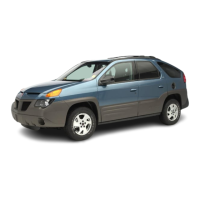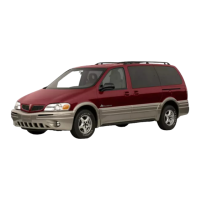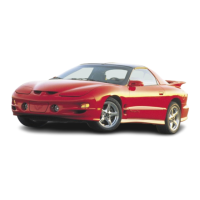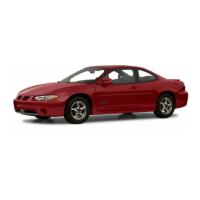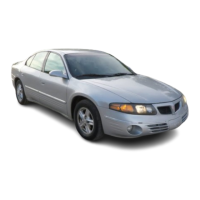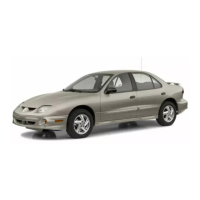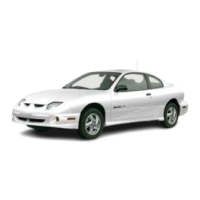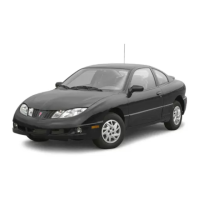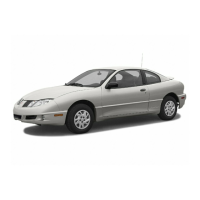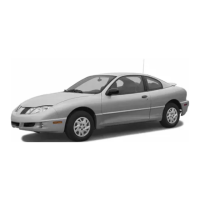Do you have a question about the Pontiac 2001 Sunfire and is the answer not in the manual?
Explains safety cautions and symbols used in the manual to highlight potential hazards.
Details on adjusting manual and easy entry front seats and reclining seatbacks.
Instructions on how to properly wear safety belts and their importance in preventing injury.
Explanation of the Supplemental Restraint System (SRS) and how airbags function.
Information on types of child restraints and how to secure them properly in the vehicle.
Guidance on checking restraint systems and replacing parts after a crash.
Details on operating manual and power windows, including lock-out features.
Information on vehicle keys, theft prevention features, and the Passlock system.
Explains the operation, features, and transmitter for the remote keyless entry system.
Instructions on how to unlock and open the trunk using various methods.
Details on ignition switch positions and procedures for starting the engine.
Guidance on automatic and manual transaxle operation, including gear selection and parking.
Information on tilt steering wheel, turn signals, and headlamp controls.
Instructions for operating windshield wipers, washers, and cruise control.
Overview of the instrument panel components, including warning lights and gauges.
Explains the standard climate control system, including fan speed, temperature, and mode settings.
Instructions for clearing windows and using the ventilation system.
Covers general audio system operation, Retained Accessory Power (RAP), and clock setting.
Details on playing the radio, finding stations, and using pushbuttons.
Guidance on adjusting bass, treble, balance, and fade for optimal sound.
Instructions for playing cassette tapes, including navigation and controls.
Details on playing CDs, including track navigation and player maintenance.
Explanation of Radio Data System features like traffic announcements and information display.
Information on the TheftLock system for preventing unauthorized radio use.
Advice on being prepared for unexpected situations and maintaining focus while driving.
Highlights the risks of driving under the influence of alcohol and its effects on driving ability.
Explanation of how brakes, steering, and accelerator systems work together for vehicle control.
Details on the function and normal operation of the anti-lock braking system.
Information on the ETS that limits wheel spin for improved traction in slippery conditions.
Tips for safe steering, especially when navigating curves at reasonable speeds.
Explains the causes of skidding and how to regain control of the vehicle.
Provides tips for safer driving during nighttime, considering visibility and driver impairment.
Guidance on driving safely in wet conditions, including hydroplaning.
Tips for navigating city streets, managing traffic, and using traffic signals.
Advice on safe freeway driving, including merging, lane changes, and speed.
Checklist for preparing your vehicle and yourself for extended journeys.
Tips for safely driving on steep inclines and declines, including gear selection.
Recommendations for preparing your vehicle and driving safely in winter conditions.
Essential information and safety rules for towing a trailer with your vehicle.
Guidance on trailer weight limits, tongue load, and vehicle capacity.
Instructions for properly attaching safety chains and checking trailer brakes.
Tips for maneuvering a trailer, including backing up and making turns.
Advice on managing engine and transaxle temperatures when driving on steep grades.
Procedure for safely parking a vehicle with a trailer attached on an incline.
Instructions on how to use hazard warning flashers to alert others.
Step-by-step guide on safely jump-starting a vehicle using jumper cables.
Information on consulting dealers or services for vehicle towing needs.
What to do if the engine overheats, including safety precautions and potential hazards.
Identification of key components in the engine cooling system.
Guidance on what to expect and do during a tire blowout or slow leak.
Step-by-step instructions for safely changing a flat tire.
Information on the proper use and limitations of the compact spare tire.
Methods for freeing a stuck vehicle, including the 'rocking' technique.
Guidance on seeking dealer service and performing your own maintenance tasks.
Information on the type of gasoline to use for optimal vehicle performance and emissions.
Instructions for checking essential under-hood components and releasing the hood.
Diagram identifying components of the 2.2L L4 engine compartment.
Diagram identifying components of the 2.4L L4 engine compartment.
Procedure for checking the engine oil level and its importance for engine health.
Guidance on selecting the correct type and viscosity of engine oil for your vehicle.
Schedules for changing engine oil and filter based on driving conditions.
Proper procedures for disposing of used oil and checking the engine air cleaner.
Instructions for checking and changing automatic transaxle fluid for three-speed models.
Information that checking automatic transaxle fluid is not necessary unless a leak occurs.
Guidance on checking the hydraulic clutch fluid level and system integrity.
Procedure for checking and adding engine coolant, including safety precautions.
Recommendations for the correct type of coolant mixture and warnings about improper use.
Instructions for checking power steering fluid level and the proper type of fluid to use.
Information on checking brake fluid level and reasons for potential decreases.
Guidance on the correct type of brake fluid to use and warnings about improper fluid.
Explanation of brake wear indicators and procedures for brake system inspection.
Information on brake pedal behavior and how to adjust rear drum brakes.
Guidance on battery maintenance, safety precautions, and vehicle storage procedures.
Step-by-step instructions for replacing halogen headlamp bulbs.
Procedure for replacing bulbs in the Center High-Mounted Stoplamp.
Instructions for replacing bulbs in the taillamps and rear turn signals.
Procedure for replacing bulbs in the back-up lamps.
Instructions for replacing bulbs in the dome lamp with reading lights.
Procedure for replacing bulbs in the dome lamp without reading lights.
Guidance on inspecting and replacing windshield wiper blades.
Information on tire maintenance, including safety and the dangers of improper use.
Instructions on checking tire pressure and the importance of proper inflation.
Guidance on inspecting tires for wear and performing tire rotation.
Indicators that signal when it is time to replace tires.
Advice on selecting the correct type and size of tires for your vehicle.
Explanation of tire grading systems for treadwear and traction performance.
Information on wheel alignment, balancing, and when to replace wheels.
List of cleaning agents that should not be used inside the vehicle due to potential damage.
Instructions for cleaning fabric and carpet, including stain removal tips.
Guidance on cleaning vinyl, instrument panel, and interior plastic components.
Instructions for cleaning safety belts and warnings against bleaching or dyeing them.
Recommendations for cleaning interior glass surfaces to avoid scratches and damage.
Procedures for cleaning the windshield, wiper blades, and weatherstrips.
Best practices for washing the vehicle's exterior to preserve the paint finish.
Instructions for cleaning exterior lamps and lenses using mild soap and water.
Tips for maintaining the vehicle's paint finish against environmental damage.
Guidance on cleaning aluminum wheels safely without causing surface damage.
Instructions for cleaning tires and ensuring proper anti-corrosion material application.
Procedures for repairing finish damage and maintaining the underbody.
List of GM-approved appearance and care products with part numbers and usage.
Explanation of the VIN's location and its importance as a legal identifier.
Information on engine codes and the service parts identification label on the spare tire cover.
Overview of fuses and circuit breakers protecting the vehicle's electrical systems.
List of fuses, their locations, and the electrical systems they protect.
Guide to replacement bulbs for various vehicle lamps, including bulb numbers.
Explains the importance of proper maintenance for vehicle condition and the environment.
Outlines the five parts of the maintenance schedule section and their content.
Introduces scheduled maintenance and how to select the appropriate service schedule.
Details maintenance intervals and services for vehicles used primarily for short trips or city driving.
Details maintenance intervals and services for vehicles used primarily for long-distance highway driving.
Lists owner-performed checks and services required at specified intervals.
Checks to perform each time the vehicle is refueled, including fluid levels.
Monthly checks, including tire inflation and cassette deck cleaning.
Semi-annual checks for restraint systems, wiper blades, and weatherstrips.
Information that manual transaxle fluid level does not require regular checking.
Lists inspections to be performed by a dealer or qualified service center at least twice a year.
Lists recommended fluids and lubricants for various vehicle systems.
Provides space to record maintenance performed and retain receipts for warranty purposes.
Explains Pontiac's commitment to customer satisfaction through various programs and services.
Steps to follow if a concern with the vehicle or dealership is not resolved.
Information for deaf, hard of hearing, or speech-impaired customers using TTY equipment.
Contact information for Pontiac Customer Assistance Centers in the US and Canada.
Details on assistance for adaptive equipment and resource information for disabled individuals.
Information on the roadside assistance program, services offered, and contact number.
Details on the roadside assistance program for vehicles purchased in Canada.
Explanation of the courtesy transportation program for warranty repairs.
Reference to the separate warranty booklet containing detailed coverage information.
Procedure for reporting vehicle safety defects to NHTSA and General Motors.
Procedure for reporting vehicle safety defects to Transport Canada and General Motors.
Contact information for reporting safety defects directly to General Motors.
Information on how to order service manuals, bulletins, and owner publications.
Explains safety cautions and symbols used in the manual to highlight potential hazards.
Details on adjusting manual and easy entry front seats and reclining seatbacks.
Instructions on how to properly wear safety belts and their importance in preventing injury.
Explanation of the Supplemental Restraint System (SRS) and how airbags function.
Information on types of child restraints and how to secure them properly in the vehicle.
Guidance on checking restraint systems and replacing parts after a crash.
Details on operating manual and power windows, including lock-out features.
Information on vehicle keys, theft prevention features, and the Passlock system.
Explains the operation, features, and transmitter for the remote keyless entry system.
Instructions on how to unlock and open the trunk using various methods.
Details on ignition switch positions and procedures for starting the engine.
Guidance on automatic and manual transaxle operation, including gear selection and parking.
Information on tilt steering wheel, turn signals, and headlamp controls.
Instructions for operating windshield wipers, washers, and cruise control.
Overview of the instrument panel components, including warning lights and gauges.
Explains the standard climate control system, including fan speed, temperature, and mode settings.
Instructions for clearing windows and using the ventilation system.
Covers general audio system operation, Retained Accessory Power (RAP), and clock setting.
Details on playing the radio, finding stations, and using pushbuttons.
Guidance on adjusting bass, treble, balance, and fade for optimal sound.
Instructions for playing cassette tapes, including navigation and controls.
Details on playing CDs, including track navigation and player maintenance.
Explanation of Radio Data System features like traffic announcements and information display.
Information on the TheftLock system for preventing unauthorized radio use.
Advice on being prepared for unexpected situations and maintaining focus while driving.
Highlights the risks of driving under the influence of alcohol and its effects on driving ability.
Explanation of how brakes, steering, and accelerator systems work together for vehicle control.
Details on the function and normal operation of the anti-lock braking system.
Information on the ETS that limits wheel spin for improved traction in slippery conditions.
Tips for safe steering, especially when navigating curves at reasonable speeds.
Explains the causes of skidding and how to regain control of the vehicle.
Provides tips for safer driving during nighttime, considering visibility and driver impairment.
Guidance on driving safely in wet conditions, including hydroplaning.
Tips for navigating city streets, managing traffic, and using traffic signals.
Advice on safe freeway driving, including merging, lane changes, and speed.
Checklist for preparing your vehicle and yourself for extended journeys.
Tips for safely driving on steep inclines and declines, including gear selection.
Recommendations for preparing your vehicle and driving safely in winter conditions.
Essential information and safety rules for towing a trailer with your vehicle.
Guidance on trailer weight limits, tongue load, and vehicle capacity.
Instructions for properly attaching safety chains and checking trailer brakes.
Tips for maneuvering a trailer, including backing up and making turns.
Advice on managing engine and transaxle temperatures when driving on steep grades.
Procedure for safely parking a vehicle with a trailer attached on an incline.
Instructions on how to use hazard warning flashers to alert others.
Step-by-step guide on safely jump-starting a vehicle using jumper cables.
Information on consulting dealers or services for vehicle towing needs.
What to do if the engine overheats, including safety precautions and potential hazards.
Identification of key components in the engine cooling system.
Guidance on what to expect and do during a tire blowout or slow leak.
Step-by-step instructions for safely changing a flat tire.
Information on the proper use and limitations of the compact spare tire.
Methods for freeing a stuck vehicle, including the 'rocking' technique.
Guidance on seeking dealer service and performing your own maintenance tasks.
Information on the type of gasoline to use for optimal vehicle performance and emissions.
Instructions for checking essential under-hood components and releasing the hood.
Diagram identifying components of the 2.2L L4 engine compartment.
Diagram identifying components of the 2.4L L4 engine compartment.
Procedure for checking the engine oil level and its importance for engine health.
Guidance on selecting the correct type and viscosity of engine oil for your vehicle.
Schedules for changing engine oil and filter based on driving conditions.
Proper procedures for disposing of used oil and checking the engine air cleaner.
Instructions for checking and changing automatic transaxle fluid for three-speed models.
Information that checking automatic transaxle fluid is not necessary unless a leak occurs.
Guidance on checking the hydraulic clutch fluid level and system integrity.
Procedure for checking and adding engine coolant, including safety precautions.
Recommendations for the correct type of coolant mixture and warnings about improper use.
Instructions for checking power steering fluid level and the proper type of fluid to use.
Information on checking brake fluid level and reasons for potential decreases.
Guidance on the correct type of brake fluid to use and warnings about improper fluid.
Explanation of brake wear indicators and procedures for brake system inspection.
Information on brake pedal behavior and how to adjust rear drum brakes.
Guidance on battery maintenance, safety precautions, and vehicle storage procedures.
Step-by-step instructions for replacing halogen headlamp bulbs.
Procedure for replacing bulbs in the Center High-Mounted Stoplamp.
Instructions for replacing bulbs in the taillamps and rear turn signals.
Procedure for replacing bulbs in the back-up lamps.
Instructions for replacing bulbs in the dome lamp with reading lights.
Procedure for replacing bulbs in the dome lamp without reading lights.
Guidance on inspecting and replacing windshield wiper blades.
Information on tire maintenance, including safety and the dangers of improper use.
Instructions on checking tire pressure and the importance of proper inflation.
Guidance on inspecting tires for wear and performing tire rotation.
Indicators that signal when it is time to replace tires.
Advice on selecting the correct type and size of tires for your vehicle.
Explanation of tire grading systems for treadwear and traction performance.
Information on wheel alignment, balancing, and when to replace wheels.
List of cleaning agents that should not be used inside the vehicle due to potential damage.
Instructions for cleaning fabric and carpet, including stain removal tips.
Guidance on cleaning vinyl, instrument panel, and interior plastic components.
Instructions for cleaning safety belts and warnings against bleaching or dyeing them.
Recommendations for cleaning interior glass surfaces to avoid scratches and damage.
Procedures for cleaning the windshield, wiper blades, and weatherstrips.
Best practices for washing the vehicle's exterior to preserve the paint finish.
Instructions for cleaning exterior lamps and lenses using mild soap and water.
Tips for maintaining the vehicle's paint finish against environmental damage.
Guidance on cleaning aluminum wheels safely without causing surface damage.
Instructions for cleaning tires and ensuring proper anti-corrosion material application.
Procedures for repairing finish damage and maintaining the underbody.
List of GM-approved appearance and care products with part numbers and usage.
Explanation of the VIN's location and its importance as a legal identifier.
Information on engine codes and the service parts identification label on the spare tire cover.
Overview of fuses and circuit breakers protecting the vehicle's electrical systems.
List of fuses, their locations, and the electrical systems they protect.
Guide to replacement bulbs for various vehicle lamps, including bulb numbers.
Explains the importance of proper maintenance for vehicle condition and the environment.
Outlines the five parts of the maintenance schedule section and their content.
Introduces scheduled maintenance and how to select the appropriate service schedule.
Details maintenance intervals and services for vehicles used primarily for short trips or city driving.
Details maintenance intervals and services for vehicles used primarily for long-distance highway driving.
Lists owner-performed checks and services required at specified intervals.
Checks to perform each time the vehicle is refueled, including fluid levels.
Monthly checks, including tire inflation and cassette deck cleaning.
Semi-annual checks for restraint systems, wiper blades, and weatherstrips.
Information that manual transaxle fluid level does not require regular checking.
Lists inspections to be performed by a dealer or qualified service center at least twice a year.
Lists recommended fluids and lubricants for various vehicle systems.
Provides space to record maintenance performed and retain receipts for warranty purposes.
Explains Pontiac's commitment to customer satisfaction through various programs and services.
Steps to follow if a concern with the vehicle or dealership is not resolved.
Information for deaf, hard of hearing, or speech-impaired customers using TTY equipment.
Contact information for Pontiac Customer Assistance Centers in the US and Canada.
Details on assistance for adaptive equipment and resource information for disabled individuals.
Information on the roadside assistance program, services offered, and contact number.
Details on the roadside assistance program for vehicles purchased in Canada.
Explanation of the courtesy transportation program for warranty repairs.
Reference to the separate warranty booklet containing detailed coverage information.
Procedure for reporting vehicle safety defects to NHTSA and General Motors.
Procedure for reporting vehicle safety defects to Transport Canada and General Motors.
Contact information for reporting safety defects directly to General Motors.
Information on how to order service manuals, bulletins, and owner publications.
| Brand | Pontiac |
|---|---|
| Model | 2001 Sunfire |
| Category | Automobile |
| Language | English |
